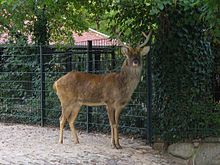Rucervus
| Rucervus | |
|---|---|

| |
| Barasingha stag | |
| Scientific classification | |
| Kingdom: | Animalia |
| Phylum: | Chordata |
| Class: | Mammalia |
| Order: | Artiodactyla |
| Family: | Cervidae |
| Subfamily: | Cervinae |
| Genus: | Rucervus Hodgson, 1838 |
| Type species | |
| Cervus duvaucelii (Cuvier, 1823)
| |
| Species | |
|
See text | |
Rucervus is a genus of deer from India, Nepal, Indochina, and the Chinese island of Hainan. The only extant representatives, the barasingha (R. duvaucelii) and Eld's deer (R. eldii), are threatened by habitat loss and hunting, and another species (R. schomburgki) became extinct in 1938.[1] The species of the genus Rucervus are characterized by a specific antler structure: its basal ramification is often supplemented with an additional small prong, the middle tine is never present, while the crown tines are inserted on the posterior side of the beam and may be bifurcated or fused into a small palmation.
Species[]
Extant species[]
- Rucervus duvaucelii (Cuvier, 1823) - barasingha or swamp deer
- Rucervus eldii (McClelland, 1842) - Eld's deer or thamin
Extinct species[]
- Rucervus ardei (Croizet & Jobert, 1828) (Pliocene, France)
- Rucervus colberti (Azzaroli, 1954) (Tertiary, Sivalik Hills)
- Rucervus gigans Croitor, 2018 (Early Pleistocene, Greece)
- Rucervus giulii (Kahlke, 1997) (Early Pleistocene, Germany)
- Rucervus radulescui Croitor, 2018 (Early Pleistocene, Romania)
- Rucervus schomburgki - Schomburgk's deer (Thailand; extinct, 1938)
- Rucervus simplicidens (Lydekker, 1876) (Tertiary, Sivalik Hills)
- Rucervus verestchagini (David, 1992) (Early Pleistocene, Moldova)
According to the old tradition of zoological taxonomy, swamp deer originally were regarded as members of the genus Cervus. Rucervus was originally proposed by Hodgson [2] as a subgenus of the genus Cervus. The original definition of Rucervus was mostly based on antler shape believed to be intermediate between that of 'elaphus' and 'hippelaphus'. Hodgson [2] reported that upper canines are present only in males of barasingha, but the additional craniological material shows that upper canines are present in both sexes.[3] Eld's deer was regarded as another species of the genus Rucervus, however, the recent genetic evidences suggest that the Eld's deer should be moved back to Cervus,[4] or placed in its own genus, Panolia.[5][6] It has recently been place back into Rucervus by the American Society of Mammalogists.[7]
Rucervus is an ancient cervid lineage that--together with the genus Axis--represents the oldest evolutionary radiation of the subfamily Cervinae (plesiometacarpal deer).[4]
Paleontological record[]
The fossil species of Rucervus of Europe were included in the genus Arvernoceros Heintz, 1971 (the type species: Cervus ardei Croizet & Jobert, 1828) or in the genus Eucladoceros, as in the case of R. giulii. Today, Arvernoceros is regarded as a subgenus of Rucervus.[3] The European fossil forms of Rucervus are distinguished from the South Asian species by more compact crown part of the antler and by the frequent development of a small distal palmation as for instance in R. ardei and R. radulescui. South Asian fossil forms of Rucervus are represented by large-sized R. simplicidens and R. colberti. The late Early Pleistocene of Greece has yielded the remains of a giant species R. gigans that rivaled in size Irish elk Megaloceros giganteus, The giant Rucervus from Greece is distinguished by unusually for such a large animal long limbs and apparently is closely related to R. simplicidens and R. colberti from the Sivaliks.[3] The Southwest-Europe endemic Mid to early Late Pleistocene genus Haploidoceros is regarded as closely allied.[8]
References[]
- ^ Ellis, Richard (2004). No Turning Back: The Life and Death of Animal Species. New York: Harper Perennial. pp. 311–312. ISBN 0-06-055804-0.
- ^ a b Hodgson, B.H. 1838. Proceedings of Learned Societies. Linnaean Society, Feb. 20, 1838. Ann. Nat. Hist., 1, 152-154.
- ^ a b c Croitor, Roman (2018-09-11). "A Description of Two New Species of the Genus Rucervus (Cervidae, Mammalia) from the Early Pleistocene of Southeast Europe, with Comments on Hominin and South Asian Ruminants Dispersals". Quaternary. 1 (2): 17. doi:10.3390/quat1020017.
- ^ a b Pitraa, Fickela, Meijaard, Groves (2004). Evolution and phylogeny of old world deer. Molecular Phylogenetics and Evolution 33: 880–895.
- ^ Groves (2006). The genus Cervus in eastern Eurasia. European Journal of Wildlife Research 52: 14–22
- ^ Groves, C. and Grubb, P. 2011. Ungulate Taxonomy. The Johns Hopkins University Press, Baltimore, USA.
- ^ "Rucervus eldii". ASM Mammal Diversity Database. 1.5. American Society of Mammalogists. Retrieved 26 August 2021.
- ^ Croitor, Roman; Sanz, Montserrat; Daura, Joan (2020-03-15). "The endemic deer Haploidoceros mediterraneus (Bonifay) (Cervidae, Mammalia) from the Late Pleistocene of Cova del Rinoceront (Iberian Peninsula): origin, ecomorphology, and paleobiology". Historical Biology. 32 (3): 409–427. doi:10.1080/08912963.2018.1499018. ISSN 0891-2963.
- Cervines
- Mammal genera
- Taxa named by Brian Houghton Hodgson